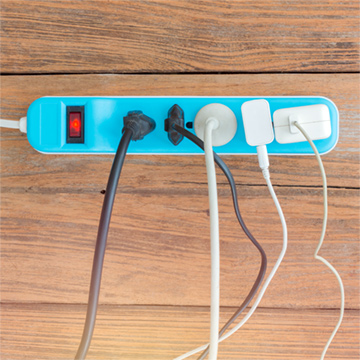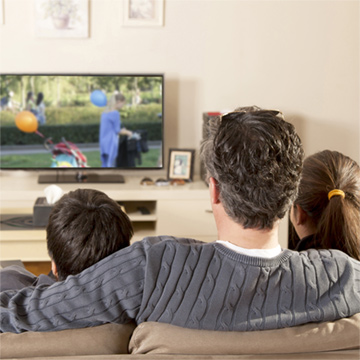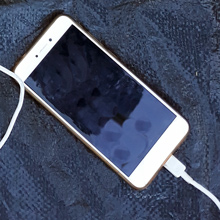Electronics
Electronic devices are the fastest growing source of residential energy consumption, and plug loads from office electronics are an increasing source of energy consumption in commercial buildings; plug loads refer to the electricity used by devices that are powered by a cord plugged into a socket. While great strides have been made in increasing the efficiency of standard appliances and lighting, the proliferation of a wide array of electronic devices has offset some of these savings.
Lawrence Berkeley Labs reports that the typical US household has 40 consumer electronics products, which account for approximately 10% of annual household energy usage. Many consumers assume that all consumer electronics products are energy efficient; this is not the case. As with standard appliances, consumers must perform research to be sure that they are buying and using the most efficient consumer electronics products.
Contact the BED Energy Services Team to borrow a portable electric meter to determine how much power your entertainment center devices consume.
Advanced Power Strips
Most electronics consume electricity when they are plugged in, even when they are turned off, the screen is blank, or the speaker is silent. This is called standby power and can be a sneaky contributor to your electric bill.  Other terms for standby power include vampire power or phantom power. Check out the Lawrence Berkeley Labs Standby Power summary table to learn what devices may be using energy when you think they are asleep. The simplest solution is to unplug devices when not in use. A device that is not plugged in cannot consume electricity.
Other terms for standby power include vampire power or phantom power. Check out the Lawrence Berkeley Labs Standby Power summary table to learn what devices may be using energy when you think they are asleep. The simplest solution is to unplug devices when not in use. A device that is not plugged in cannot consume electricity.
Using a power strip guarantees that no energy will be used by any of the devices plugged into it when that power strip is turned off.
Shop Discounted Advanced Power Strips
Smart power strips are able to detect when devices have been switched OFF and cut all power to those devices. They eliminate the standby power draws and the need for any action from the user beyond switching OFF devices. Some smart power strips even have a “Controller outlet” that will cut power to all peripheral devices when the “Controller device” is switched OFF. For example, a smart power strip can be set up so that when the TV is turned off, power also will be cut off to the speakers, Blu-ray player, streaming device, and any other selected devices.
These smart power strips can help you save up to $200 per year by avoiding standby power costs. Check out the National Renewable Energy Laboratory guide to choose the right advanced power strip for your home.
Entertainment Centers
Entertainment centers are a substantial source of electricity use in homes, especially if the people in your home enjoy watching television. Gaming consoles used to play video games on your television can be large contributors to electric bills both when they are in use, as well as when they are turned off or in sleep mode.
- Consider using advanced power strips to simultaneously turn off multiple electronics in your entertainment center to reduce standby power. For instance, when your streaming media player or game console is turned off, the power strip could shut off your TV and speaker system as well.
- Avoid larger displays and using multiple televisions in your home as both can result in increased energy usage.
- Avoid using the “instant on” feature on your television and/or gaming console to reduce standby power consumption by 50%.
- Gaming consoles can use just as much electricity in the off mode as they do while in use. When you’re done playing, turn off the console completely and unplug it (or disable the outlet with an advanced power strip).
- Be aware that features such as Ultra High Definition (4K and 8K) and High Dynamic Resolution (HDR) can use significant amounts of energy and negate the energy savings of modern energy-efficient television displays.
- Reduce picture brightness and contrast to cut energy consumption by up to 50%.
- If your TV has an auto dimming feature, enable it so TV brightness is automatically adjusted in response to ambient light levels.
- Use the programmable “sleep” timer feature when available.
- Utilize “power save” or other energy saving settings on your TV to optimize energy efficiency.
Purchasing Televisions
- Consider buying a new LED television rather than purchasing a used TV with older display technology. LED television displays have become the norm, and consume considerably less electricity than legacy Cathode Ray Tube (CRT) displays and around 20 – 30% less than older plasma displays.
- Buy a TV certified with the ENERGY STAR® label. Check out the Buying Guidance section of their website for helpful purchase information.
- Consult the yellow EnergyGuide label to compare the estimated annual energy usage of your preferred options.
Set Top Boxes
Set top boxes (Cable, Satellite, DVRs, and Streaming) have historically been one of the larger plug loads in the home, and consume considerable standby power when they are turned off. These devices use a good amount of power when standing by because they need to be available to receive new programming from the service provider at any time of the day or night, and to turn on immediately when the TV is enabled.
Set top box efficiency has improved greatly since 2014 due to an agreement between the largest service providers in the US and environmental advocates. Under this agreement cable and satellite service providers have committed to distribute greater numbers of energy efficient set top boxes.
When subscribing to new cable or satellite service ask about energy efficient set top box options, such as an ENERGY STAR certified set top box. If you are concerned with the power draw of your existing cable or satellite set top box, contact your service provider to learn more about the energy efficiency of their devices.
Work & Home Offices
Computers, Monitors, Laptops
Laptops are more energy efficient than desktop personal computers (PCs) by design, to maximize laptop runtime when operating on battery power. Laptops use as little as 25% of the electrical consumption of a standard desktop PC.
Gaming PCs are powerful computing tools that provide exceptional computing speed, accompanied by high-caliber video and audio performance; these features result in significant energy consumption. A recent study from Lawrence Berkeley Labs found that a typical gaming PC consumes a much electricity each year as three refrigerators. 
Computer Energy Usage
- ENERGY STAR-certified PCs and laptops have power management features built into their operating software. These power management features allow the user to select the energy savings settings (when to sleep, when to dim the screen) that work best for them.
- Put your computer into sleep mode when not in use.
- Turn off monitors when computer is not in use.
Purchasing Personal Computers
- Purchase computers that have low standby power consumption. The U.S. Department of Energy manages a list of low standby power products; check out their website to learn about listed options.
- Buy a certified model with the ENERGY STAR® label. Check out the Buying Guidance section of their website for helpful purchase information.
- Right-size the power supply for your PC and choose an “80 PLUS” Gold-certified product.
- 80 PLUS power supplies have been tested and certified to run at 80% efficiency at 20%, 50%, and 100% of full load.
- 80 PLUS-certified power supplies are not only substantially more energy efficient than traditional power supplies, but they also run cooler and quieter than standard power supplies, and
- Check out the list of 80 PLUS PC power supplies to find a suitable solution for your computer.
Chargers for Electronic Devices
 For each of the electronic devices a home has, there is often a charging cord. Beyond the tangled mess these chargers entail, they can contribute to significant standby energy losses when not in use.
For each of the electronic devices a home has, there is often a charging cord. Beyond the tangled mess these chargers entail, they can contribute to significant standby energy losses when not in use.
Fortunately, the efficiency of electric chargers is improving. On June 18, 2018 new Federal Standards for battery chargers came into effect, impacting hundreds of millions of battery chargers that are manufactured, imported and sold in the US each year.
To reduce the standby energy use of older legacy chargers that predate the new Federal Standard, use a power strip with a remote switch (such as the Belkin Conserve power strip) to easily turn off all of the connected chargers with just the flip of a single switch.

